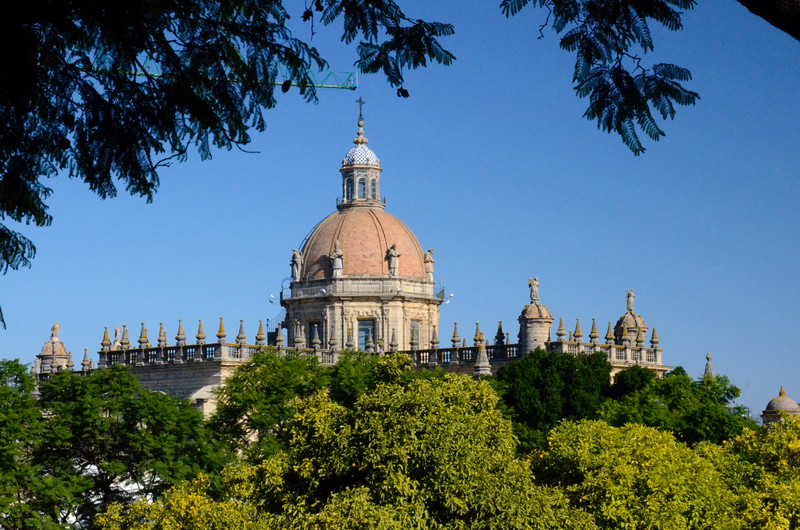Our transatlantic Royal Caribbean ship docked in Cadiz at 8AM giving us plenty of time for breakfast. Once again, to be on the safe side, we signed up for the ship tour, this time our last exploration of Spain: Cadiz and Jerez de la Frontera. Booking the ships tour gave us assurity that the ship would not sail without us! The ship was scheduled to depart at 6PM which gave us ample time to explore a bit on our own before heading back to dinner aboard ship.
Thankfully we left the ship well in advance of our 10AM tour, After a confusing and worrisome 10 minute walk from the ships dock, including asking many questions of anyone on the street, we finally found the location where we met our guide Jose to begin the 6 hour tour of this region. Jose guided us to his van and we were off driving north to Jerez de la Frontera. During the half hour drive Jose gave us a little history and background of this area.
from the Phoenician word for Ceres the goddess of agriculture, later changed to cerred in Roman, and finally the
Muslims Sherrish. Our word from this. We were told that this region is famous for its production of wheat sherry wine. From the bus I spotted the large Tio Pepe Bull sign along the way. Tio Pepe, the most famous sherry of the region, originated from a visit to the region by a man bringing a cask of his favorite beverage, different from what the locals had been drinking. The story spread as stories do and this beverage became Uncle Josephs wine that loosely translated to the Spanish ‘Tio Pepe. It claims to be the driest, and most popular version of wheat sherry followed by Fino. The sweet Jerez wines often called cream or amoroso, have a strong base of the Phoenican Palomino grape with aromas of chocolate, spices or candied fruit, with a proportion of Pedro Ximenez making it the sweetest. Before being pressed, these grapes are exposed to sunlight until they dried achieving the consistency of plump raisins, that results in a rich sweetness. (Later that afternoon I decided to try some sherry before I left this region so I stopped in Bar 1 De Labra in Cadiz to sample the sweet and dry drink.
I blindly ordered what Id hoped would be good but took one sip and thought it was awful. I was too embarrassed to just leave so I politely sucked down what I could, paid and left. I guess sherry is just not my drink.)
We began our walking tour of Jerez outside the imposing protective walls of the Alcazar, a Moorish fortress and palace. In 1931 the former Moorish palace and Alcazar of Jerez de la Frontera was turned into a cultural interest. It is located in a small park in Jerez. The palace/fortress was likely built in the 11th century, when Jerez was part of a small kingdom of the Taifa of Arcos de la Frontera. The fortress stone walls were massive dominating the now peaceful space.
Jose continued his history lesson reminding us that in 711 the Moors arrived, defeating the Visigoths and 800 years later, the Christians came and conquered Jerez. Jose pointed out an interesting cultural difference: Christians ate rabbits, Jews didnt, Muslims washed five times a day, Christians only once a year. Im not sure that was progress. After the conquest of the Americas and Granada, Jerez became one of the most prosperous
Passing by the city walls, we walked to the Alameda, a space surrounded by trees, in this case, orange trees. As we walked along Orange Tree Boulevard, Jose told us that oranges are used as ornamental trees here. I wondered about the mess of fruit drop and was told they have people collecting the drops. Sour oranges have a unique, shiny large leaf with a small leaf behind and are not popular here but they are made into marmalade for export.
The citys namesake cathedral, which used to be a mosque, is located in the Plaza de la Encarnacion. This 17th century gothic Cathedral of Jerez or Cathedral of San Salvador with its gothic gargoyles was once known as the Wine Cathedral and a special tax was levied for its production of wine.
Travelmates near









